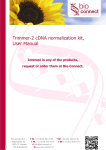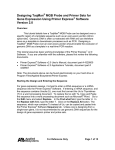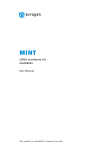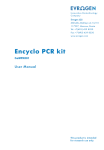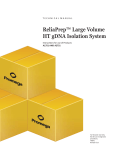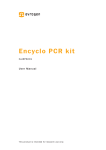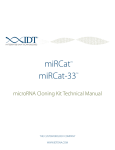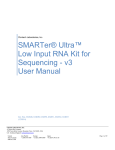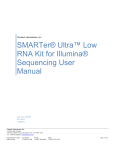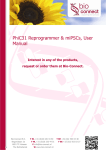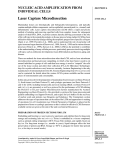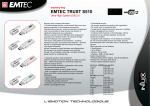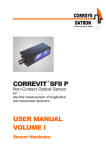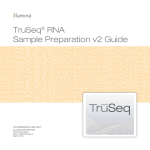Download Mint-2 cDNA synthesis kit, User Manual - Bio
Transcript
Mint-2 cDNA synthesis kit, User Manual Interest in any of the products, request or order them at Bio-Connect. Bio-Connect B.V. Begonialaan 3a 6851 TE Huissen The Netherlands T NL +31 (0)26 326 44 50 F NL +31 (0)26 326 44 51 E [email protected] W www.bio-connect.nl T BE +32 (0)2 503 03 48 F BE +32 (0)2 503 03 27 Mint-2 cDNA synthesis kit Cat # SK005 User manual PLEASE READ THE ENTIRE MANUAL BEFORE STARTING Contents I Intended use . . . . . . . . . . . . . . . . . . . . . . . . . . . . 1 II Method overview . . . . . . . . . . . . . . . . . . . . . . . . . . 1 III Applications and adapters . . . . . . . . . . . . . . . . . . . . 3 IV Kit components and storage conditions . . . . . . . . . . . . . 5 IV. A List of kit components . . . . . . . . . . . . . . . . . . . IV. B Reagents required but not included 5 . . . . . . . . . . . 6 General considerations . . . . . . . . . . . . . . . . . . . . . . 7 VI RNA requirements . . . . . . . . . . . . . . . . . . . . . . . . . 8 V VII cDNA preparation protocol . . . . . . . . . . . . . . . . . . . . 10 VII. A First-strand cDNA synthesis and PlugOligo incorporation 10 VII. B ds cDNA synthesis and amplification . . . . . . . . . . . 12 VII. B.1 Evaluative PCR . . . . . . . . . . . . . . . . . . 12 VII. B.2 Full-scale preparation of ds cDNA . . . . . . . . 15 VIII Recommendations for further processing of amplified ds cDNA 17 IX Troubleshooting . . . . . . . . . . . . . . . . . . . . . . . . . . 18 X References . . . . . . . . . . . . . . . . . . . . . . . . . . . . . 22 Appendix A Recommendations for performing non-denaturing agarose gel electrophoresis of RNA . . . . . . . . . . . 23 Appendix B Processing of ds cDNA flanked with PlugOligo-3M and CDS-4M adapters before directional cloning . . . . . . 24 Appendix C Processing of ds cDNA flanked with PlugOligo-3M and CDS-4M adapters before SOLiD or Illumina sequencing 25 Appendix D Processing of ds cDNA flanked with PlugOligo-3M and CDS-4M adapters before Roche 454 sequencing . . . 27 Appendix E Processing of ds cDNA flanked with PlugOligo-3M and CDS-Gsu adapters before Roche 454 sequencing . . . 29 Endnotes . . . . . . . . . . . . . . . . . . . . . . . . . . . . . . . . 33 For important information about the use of the Mint-2 kit, please see the ENDNOTES at the end of this User Manual. I Intended use I Intended use Mint-2 cDNA synthesis kit is designed to synthesize full-length-enriched double stranded (ds) cDNA from total or poly(A)+ RNA. Synthesized cDNA can be used in various applications including construction of cDNA libraries, subtractive hybridization (SSH), cDNA normalization using Evrogen Trimmer kits, high-throughput sequencing on the next generation sequencing platforms (Roche/454, ABI/SOLiD or Illumina/Solexa), and other applications. II Method overview Mint-2 cDNA synthesis kit utilizes the specific features of Mint reverse transcriptase (Mint RT). The cDNA synthesis procedure is illustrated in Fig. 1. First strand cDNA synthesis starts from the 3’-end CDS adapter containing an oligo(dT) sequence that anneals to poly(A) stretches of RNA. When Mint RT reaches the 5’-end of the mRNA, it adds several non-template nucleotides, primarily deoxycytidines, to the 3’-end of the newly synthesized first-strand cDNA [5]. This oligo(dC) stretch base pairs to complementary oligo(dG) sequence located at the 3’-end of a special deoxyribooligonucleotide adapter, called PlugOligo. Mint RT identifies PlugOligo as an extra part of the RNA-template and continues first strand cDNA synthesis to the end of the oligonucleotide, thus incorporating PlugOligo sequence into the 5’-end of cDNA. The last 3’-dG residue of the PlugOligo is a terminator nucleotide containing a 3’-phosphate group. This blocking group prevents unwanted extension of the PlugOligo. Under standard conditions Mint RT can hardly use PlugOligo as a template; however, a specially tailored IP-solution (solution for Incorporation of PlugOligo sequence) dramatically increases the efficiency of this process. At the final step, ds cDNA is amplified by PCR. Use of Encyclo polymerase and specially designed primers allows synthesis of full-length-enriched cDNA that is flanked by PlugOligo and CDS adapter sequences. www.evrogen.com 1 II Method overview RNA AAAA First strand cDNA synthesis 3‘ - end CDS adapter TTTT AAAA TTTT Mint RT AAAA TTTT CCCC 5’ - end PlugOligo adapter 3‘P PlugOligo Incorporation GGGG 3‘P IP-solution GGGG .... .... .... .... CCCC AAAA TTTT 3‘P GGGG .... .... .... .... CCCC AAAA TTTT ds cDNA preparation by PCR PCR primer M1 GGGG CCCC AAAA TTTT Amplified cDNA Intended downstream application Fig. 1. Schematic outline of Mint-2 cDNA synthesis. The rectangles represent the adapter and primer sequences and their complements. Within the rectangles, grey indicates the common external parts of the adapters, while black and white correspond to the internal parts that differ between the 3’-end and 5’-end adapters. 2 Mint-2 cDNA synthesis kit III Applications and adapters III Applications and adapters Mint-2 cDNA synthesis kit contains different PlugOligo and CDS adapters allowing synthesis of cDNA with different flanking sequences. The choice of the adapter pair to use for a particular cDNA preparation depends on intended application. Please refer to the section below to choose the pair of adapters suitable for your needs. Applications 5’-end adapter 3’-end adapter • Non-directional cDNA library cloning PlugOligo-1 CDS-1 • Sanger sequencing • Isolation of full-length cDNAs, RACE • cDNA normalization followed by non-directional cloning of normalized cDNA library and/or Sanger sequencing Commentary: The adapters contain extensive common parts and RsaI restriction sites. They allow synthesis of cDNA flanked by identical sequences at 3’- and 5’-ends. The length of the adapters is kept to a minimum, which improves the quality of the resulting cDNA. Applications 5’-end adapter 3’-end adapter • Directional cloning of cDNA library PlugOligo-3M CDS-4M • SOLiD or Illumina sequencing • cDNA normalization followed by directional cloning of normalized cDNA library for functional screenings or SOLiD and Illumina sequencing Commentary: The adapters contain asymmetric sites for SfiI restriction (SfiA and SfiB; Fig. 2). Being incorporated at the 5’ and 3’ ends of the cDNA the sites allow directional cloning of the cDNA library. After digestion with SfiI restriction endonuclease and size fractionation, synthesized cDNA can be ligated into an appropriate SfiI-digested vector. Since SfiI digestion cuts off the excessive parts of flanking adapters, it also makes the resulting cDNA perfectly suitable for SOLiD or Illumina sequencing. www.evrogen.com 3 III Applications and adapters Applications 5’-end adapter 3’-end adapter • Roche/454 sequencing PlugOligo-3M CDS-4M or • cDNA normalization followed by CDS-Gsu Roche/454 sequencing Commentary: The presence of long poly(A:T) tails in cDNA may result in sequencing reads of low quality when using Roche/454 sequencing platform. The Mint-2 kit contains two alternative 3’-end adapters designed to overcome this problem: - CDS-4M adapter contains a poly(T) part built of thymidines interspersed with other nucleotides. The adapter works well for cDNA synthesis and allows 454 sequencing through the modified poly(A:T) tails of cDNA. - CDS-Gsu adapter contains a GsuI recognition site (Fig. 2) just upstream of the unmodified poly(T) sequence. GsuI is a type II restriction enzyme that cuts cDNA within the poly(A) tail, reducing its length so that all subsequent sequences start with a shorter run of thymidines. Both CDS-4M and CDS-Gsu adapters allow synthesis of cDNA suitable for Roche/454 sequencing. The choice of a particular adapter should be made by the end user. Use of CDS-4M adapter does not require an additional digestion step before cDNA sequencing, however even modified poly(A:T) tails of cDNA may affect the sequence quality on some Roche/454 platforms. cDNA prepared with CDS-Gsu adapter and digested by GsuI enzyme contains shorter poly(A:T) tails that do not harm sequencing. However cDNAs containing intrinsic GsuI recognition sites will be digested as well, potentially resulting in difficulties with contig assembly. SfiIB site O 5’ – GGCCGCCTCGGCC – 3’ 3’ – CCGGCGGAGCCGG – 5’ O SfiIA site O 5’ – GGCCATTACGGCC – 3’ 3’ – CCGGTAATGCCGG – 5’ O GsuI site O 5’ – CTGGAG(N)16 – 3’ 3’ – GACCTC(N)14 – 5’ O Fig. 2. SfiI and GsuI recognition sites. 4 Mint-2 cDNA synthesis kit IV Kit components and storage conditions IV IV. A Kit components and storage conditions List of kit components Mint-2 cDNA synthesis kit provides components for 20 reactions of ds cDNA synthesis. The kit is supplied with adapters that allow synthesis of cDNA with different flanking sequences. The choice of adapters to use for a particular cDNA preparation depends on the intended application. Please refer to the section III (Applications and adapters) to choose the pair of adapters suitable for your needs. Package of the kit includes a free sample of Mint reverse transcriptase for first-strand cDNA synthesis and a free Encyclo PCR kit (Cat.# PK001). Component Amount 5X First-strand buffer 80 𝜇L DTT (20mM) 30 𝜇L 120 𝜇L dNTP mix (10mM each) 20 𝜇L Mint reverse transcriptase IP-solution 130 𝜇L 50X Encyclo polymerase mix 100 𝜇L 10X Encyclo buffer 600 𝜇L PCR primer M1 (10 𝜇M) 150 𝜇L 5’-AAGCAGTGGTATCAACGCAGAGT-3’ 454 PCR Primer mix (10 𝜇M each) 100 𝜇L 5’-CAACGCAGAGTGGCCATTAC-3’ 5’-ACGCAGAGTGGCCGAGGCGGCCTTTTGTCTTTTCTTCTGTTTCTTTT-3’ Sterile RNase free water Control total RNA template (0.35 𝜇g/𝜇L) 2 x 1.8 ml 30 𝜇L to be continued www.evrogen.com 5 IV Kit components and storage conditions Component Amount 25 𝜇L Control cDNA sample (for electrophoresis) 5’-end PlugOligo adapters PlugOligo-1 adapter (15 𝜇M) 25 𝜇L 5’-AAGCAGTGGTATCAACGCAGAGTACGGGGG-3’ 25 𝜇L PlugOligo-3M adapter (15 𝜇M) 5’-AAGCAGTGGTATCAACGCAGAGTGGCCATTACGGCCGGGGG-3’ 3’-end CDS adapters CDS-1 adapter (10 𝜇M) 5’-AAGCAGTGGTATCAACGCAGAGTAC(T)30 VN -3’ CDS-Gsu adapter (10 𝜇M) 25 𝜇L 5’-AAGCAGTGGTATCAACGCAGAGTACTGGAG(T)20 VN-3’ CDS-4M adapter (10 𝜇M) 25 𝜇L 5’-AAGCAGTGGTATCAACGCAGAGTGGCCGAGGCGGCC(T)4 G(T)6 C(T)13 VN-3’ RsaI, SfiI and GsuI restriction sites are underlined; N = A, C, G or T; V = A, G or C. Shipping & Storage Encyclo polymerase mix, Mint reverse transcriptase, PlugOligo adapters and control RNA are shipped at -20°C (or below). All other components of the kit can be shipped at ambient temperature. Upon arrival, the kit must be stored at -20°C. IV. B Reagents required but not included • Biology grade mineral oil • RNase inhibitor (20 U/𝜇L, Ambion) /optional • Agarose gel electrophoresis reagents • DNA size markers (1-kb DNA ladder) • QIAquick PCR purification kit (Cat.# 28104 or 28106, QIAGEN Inc.) 6 Mint-2 cDNA synthesis kit V General considerations V General considerations • Wear gloves to protect RNA and cDNA samples from degradation by nucleases. • If possible, perform cDNA synthesis, PCR reaction preparation and post-PCR analysis in separate laboratory areas to avoid cross-contamination of samples. • Use PCR pipette tips containing hydrophobic filters to minimize contamination. • We recommend that you perform a positive control cDNA synthesis from the total RNA provided in the kit in parallel with your experiment. This control is performed to verify that all components are working properly. • After the solution is just thawed, we strongly recommend that you mix it by gently flicking the tube, then spin the tube briefly in a microcentrifuge to deposit contents at the bottom before use. • Add enzyme to the reaction mixture last and thoroughly mix it by gently pipetting the reaction mixture up and down. Do not increase the amount of enzymes added or concentration of RNA and cDNA in the reactions. The amounts and concentrations have been carefully optimized. • Thin-wall PCR tubes are recommended. These PCR tubes are optimized to ensure more efficient heat transfer and to maximize thermal-cycling performance. We recommend that you use 0.2 ml PCR tubes rather than 0.5 ml ones. • PCR cycling parameters in the protocol are optimized for an MJ Research PTC-200 DNA Machine. Please note that the optimal parameters may vary when different thermal cyclers and templates are used. www.evrogen.com 7 VI RNA requirements VI RNA requirements 1. The sequence complexity and average length of the cDNA obtained largely depend on the quality and amount of the starting RNA material used to prepare the cDNA. • For best results, 1-2 𝜇g of total RNA or 0.5-1 𝜇g of poly(A)+ RNA should be used at the beginning of first-strand cDNA synthesis. The minimum amount of starting RNA for cDNA synthesis is 250 ng of total RNA or 100 ng of poly(A)+ RNA. • The RNA may be isolated using a number of suitable methods that yield stable RNA preparations from most biological sources, including the TRIzol method (Gibco/Life Technologies) and the RNeasy kits (Qiagen). Total RNA can also be isolated by the well-known method of guanidinium thiocyanate-phenol-chloroform extraction [1], with one variation: all procedures should be performed at neutral pH instead of the acidic pH originally suggested [3]. • Following RNA isolation, RNA quality should be controlled using denaturing formaldehyde/agarose gel electrophoresis, as described by Sambrook [4]. Alternatively, standard agarose/ethidium bromide (EtBr) gel electrophoresis can be used to quickly estimate RNA quality (see Appendix A for recommendations on non-denaturing agarose gel electrophoresis of RNA). 2. The following characteristics indicate successful RNA preparation: • For mammalian total RNA, two intensive bands at approximately 4.5 and 1.9 kb should be observed against a light smear. These bands represent 28S and 18S rRNA. The ratio of intensities of these bands should be about 1.5-2.5:1. Intact mammalian poly(A)+ RNA appears as a smear sized from 0.1 to 4-7 (or more) kb with faint 28S and 18S rRNA bands. • Normal smears of RNA from other sources (plants, insects, yeast, and amphibians) usually do not exceed 2-3 kb on the non-denaturing agarose gel. Moreover, many invertebrates have 28S rRNA 8 Mint-2 cDNA synthesis kit VI RNA requirements with a so-called "hidden break" [2]. In some organisms, the interaction between the parts of 28S rRNA is rather weak, so the total RNA preparation exhibits a single 18S-like rRNA band even on a non-denaturing gel. In other species, the 28S rRNA is more robust, so it is still visible as a second band. I Note: If experimental RNA is shorter than expected and/or degraded according to electrophoresis data, prepare fresh RNA after checking the quality of RNA purification reagents. If problems persist, you may need to find another source of tissue/cells. In some cases, partially degraded RNA is only available (e.g. tumor samples or hard treated tissues). This RNA can be used for cDNA preparation; however the cDNA sample will contain a reduced number of full-length molecules. • In general, genomic DNA contamination does not affect cDNA synthesis, meaning that DNase treatment is not usually required. When necessary, excess genomic DNA can be removed by LiCl precipitation or phenol:chloroform extraction. www.evrogen.com 9 VII cDNA preparation protocol VII cDNA preparation protocol PLEASE READ THE ENTIRE PROTOCOL BEFORE STARTING Important notes: I Before you begin the first cDNA synthesis procedure, shake all solutions and spin the tubes briefly in a microcentrifuge. I To verify that all kit components are working properly, perform a positive control cDNA synthesis with human RNA provided in the kit in parallel with the experimental samples. VII. A First-strand cDNA synthesis and PlugOligo incorporation I Note: During the first strand cDNA synthesis, the use of a thermal cycler for incubation steps is recommended. Using the air thermostat may require additional optimization. 1. Immediately before taking the aliquot for the cDNA synthesis, heat the RNA samples at 65°C for 1-2 min, mix the contents by gently flicking the tube (to prevent RNA aggregation), and then spin the tube briefly in a microcentrifuge. 2. For each RNA sample, combine the following reagents in a sterile PCR tube: 3 𝜇L RNA solution in Sterile RNase-free water (1-2 𝜇g of total RNA or 0.5-1 𝜇g of poly(A)+ RNA) For the control reaction use 3 𝜇L of the control RNA 1 𝜇L CDS-Adapter (10 𝜇M)* 1 𝜇L PlugOligo-Adapter (10 𝜇M)* 5 𝜇L Total volume *See Section III “Applications and adapters” to choose the adapter pair suitable for your task. 3. Gently pipette the reaction mixtures and spin the tubes briefly in a microcentrifuge. If the utilized thermal cycler is not equipped with a heated lid, overlay each reaction with a drop of molecular biologygrade mineral oil to prevent the loss of volume due to evaporation. 10 Mint-2 cDNA synthesis kit VII cDNA preparation protocol 4. Incubate the mixture in a thermal cycler at 70°C for 2 min (use heated lid). 5. Decrease the incubation temperature to 42°C. Keep the tubes in the thermal cycler at 42°C while preparing the RT master mix (∼ 1 to 3 min). 6. While steps 4 and 5 are ongoing, prepare an RT master mix for each reaction tube by combining the following reagents in the order shown: 2 𝜇L 5X First-strand buffer 1 𝜇L DTT (20 mM) 1 𝜇L dNTP (10 mM each) 1 𝜇L Mint reverse transcriptase 5 𝜇L Total volume I Note: Optionally, 0.5 𝜇L of RNase inhibitor (20 U/𝜇L) can be added to the reaction to prevent RNA degradation during cDNA synthesis. 7. Gently pipette the RT master mix and spin the tube briefly in a microcentrifuge. 8. Add 5 𝜇L RT master mix to each reaction tube from step 5. Gently pipette the reaction mix, and spin the tubes briefly in a microcentrifuge to deposit contents at the bottom. I Note: Do not remove the reaction tubes from the thermal cycler ex cept for the time necessary to add the RT master mix. 9. Incubate the tubes at 42°C for 30 min and then proceed immediately to step 10. 10. Add 5 𝜇L IP-solution to each reaction tube, mix by gently pipetting, if required spin the tubes briefly in a microcentrifuge and incubate for 1.5 h at 42°C. I Note: Do not remove the reaction tubes from the thermal cycler ex cept for the time necessary to add IP-solution. www.evrogen.com 11 VII cDNA preparation protocol 11. After incubation, place the tubes on ice to terminate the first-strand cDNA synthesis. I Note: Brown sediment may be generated in the reaction(s). It does not affect following procedures. First-strand cDNA can be stored at -20℃ for up to one month and used for ds cDNA synthesis and amplification (Section VII. B) VII. B ds cDNA synthesis and amplification Important note: I Use of the optimal number of PCR cycles ensures that the ds cDNA re mains in the exponential phase of amplification. PCR overcycling yields nonspecific PCR products and is extremely undesirable for many applica tions. PCR undercycling results in a lower yield of PCR product. The optimal number of PCR cycles must be determined individually for each experimental sample. This protocol includes the procedure of evaluative PCR in a small reaction volume to determine the optimal number of PCR cycles (section VII. B.1) and subsequent full-scale preparation of ds cDNA (section VII. B.2). VII. B.1 Evaluative PCR 12. For each first-strand cDNA sample from step 11, prepare a PCR mixture by combining the following reagents in the order shown: 80 𝜇L Sterile RNase-free water 10 𝜇L 10X Encyclo buffer 2 𝜇L dNTP mix (10 mM each) 4 𝜇L PCR primer-M1 (10 𝜇M) 2 𝜇L First-strand cDNA (from step 11) 2 𝜇L 50X Encyclo polymerase mix 100 𝜇L Total volume I Note: If the first-strand cDNA samples were stored at -20℃, pre-heat them at 65℃ for 1 min, then mix by gently flicking the tubes before taking aliquots. Store the remaining first-strand cDNA at -20℃. 12 Mint-2 cDNA synthesis kit VII cDNA preparation protocol 13. Mix the contents by gently flicking the tube. Spin the tube briefly in a microcentrifuge. 14. Aliquot 24 𝜇L into four 0.2 ml PCR tubes. Label the tubes as <S>1, <S>2, <S>3 and <S>4, wherein <S> is a sample identifier. I Note: Four tubes containing 24 𝜇L of the PCR mixture should be prepared for each first strand cDNA sample. 15. Overlay each reaction with a drop of mineral oil. I Note: Because of the small reaction volume, we recommend that you perform evaluative PCR under mineral oil even if you use a thermal cycler equipped with a heated lid. 16. Subject the tubes to PCR cycling using the following program: Initial denaturation 1 cycle 95°C 1 min Cycling X cycles* 95°C 15 sec 66°C 20 sec 72°C 3 min 66°C 20 sec 72°C 3 min Final extension 1 cycle *X is a number of cycles, which is set as 15 for <S>1, 18 for <S>2, 21 for <S>3 and 24 for <S>4 tubes. 17. When cycling is complete, analyze 4 𝜇L of the PCR products alongside 0.1 𝜇g of 1 kb DNA ladder and 4 𝜇L of Control cDNA sample on a 1.2% (w/v) agarose/EtBr gel run in 1X TAE buffer. 18. Determine the optimal number of cycles required for amplification of the cDNA, as follows: the optimal number of cycles should be one or two cycles less than that needed to reach the plateau. For comparison, Fig. 3 shows the characteristic gel profiles of amplified cDNA synthesized on the basis of total human brain RNA after different numbers of PCR cycles: • A typical electrophoresis result indicating an optimal number of PCR cycles should appear as a moderately strong cDNA smear www.evrogen.com 13 VII cDNA preparation protocol M 1 2 3 4 5.0 3.0 1.5 1.0 15 18 21 24 PCR cycles C Fig. 3. A characteristic gel profile of ds cDNA synthesized from 1 𝜇g of the control human brain total RNA following the Mint-2 protocol. Lane 1 – PCR product after 15 cycles; lane 2 – after 18 cycles; lane 3 – after 21 cycles; lane 4 – after 24 cycles; C – control cDNA sample; M – 1 kb DNA ladder (SibEnzyme). After 21 cycles, a smear appeared in the high-molecular-weight region of the gel, indicating that the reaction is overcycled. Because the plateau was reached after 20 cycles, the optimal cycle number for this experiment is 18-19. of the expected size distribution, with several bright bands corresponding to abundant transcripts. I In general, for most mammalian tissues a visible smear of full-length -enriched cDNA should be within the range of 0.5-7 kb, while normal cDNA size for many non-mammalian species is less than 3 kb (Fig. 4). • If the cDNA smear appears in the high-molecular-weight region of the gel, especially if no bright bands are distinguishable (e.g. as Fig. 3, lane 4), PCR overcycling may be an issue (see Troubleshooting, Section IX). • If the smear is faint (Fig. 3, lane 1), this indicates that too few PCR cycles were used for amplification. 19. In the case of PCR undercycling in all <S>1-<S>4 samples, subject the samples to two or three more cycles and repeat steps 17-18. I The representative abundances of the resulting amplified cDNA pop ulation and the number of PCR cycles required to amplify the cDNA to about 5-10 ng/𝜇L (i.e., a level that is visible on an agarose/EtBr gel) strongly depend on the initial number of target DNA molecules used for PCR amplification. If the cDNA amplification requires more than 26 PCR cycles, the cDNA may not contain rare transcripts. If no PCR product is observed or the product is low-yield after 25 cycles, see Troubleshooting, Section IX. 14 Mint-2 cDNA synthesis kit VII cDNA preparation protocol M 1 2 3 4 5 6 M 7 8 9 Fig. 4. Agarose gel-electrophoresis of Mint-2 amplified cDNA from different sources. 1 – mouse liver; 2 – mouse skeletal muscle; 3 – mouse brain; 4 – human leucocytes; 5 – human lung; 6 – human skeletal muscle; 7 – mosquito grub; 8 – copepod Pontella sp.; 9 – tomato Lycopersicon esculentum. M – 1 kb DNA ladder (SibEnzyme). 5.0 3.0 1.5 1.0 VII. B.2 Full-scale preparation of ds cDNA 20. For each first-strand cDNA sample from step 11, prepare a PCR mixture by combining the following reagents in the order shown: 40 𝜇L Sterile RNase-free water 5 𝜇L 10X Encyclo buffer 1 𝜇L dNTP mix (10 mM each) 2 𝜇L PCR primer-M1 (10 𝜇M) 1 𝜇L First-strand cDNA (from step 11) 1 𝜇L 50X Encyclo polymerase mix 50 𝜇L Total volume I Note: If the first-strand cDNA samples were stored at -20℃, pre-heat them at 65℃ for 1 min, then mix by gently flicking the tubes before taking aliquots. Store the remaining first-strand cDNA at -20℃. 21. Mix the contents by gently flicking the tubes. Spin the tubes briefly in a microcentrifuge. 22. If the thermal cycler used is not equipped with a heated lid, overlay each reaction with a drop of mineral oil. Close the tubes, and place them into a thermal cycler. www.evrogen.com 15 VII cDNA preparation protocol 23. Subject the tubes to PCR cycling using the following program: Initial denaturation 1 cycle 95°C 1 min Cycling X cycles* 95°C 15 sec 66°C 20 sec 72°C 3 min 66°C 20 sec 72°C 3 min Final extension 1 cycle *X is the optimal number of PCR cycles determined in steps 18-19 24. When cycling is complete, immediately proceed with purification of the amplified ds cDNA to remove primer excess, dNTPs, salts and enzymes using QIAquick PCR Purification Kit. Elute ds cDNA with 50 𝜇L of sterile RNase-free water. 25. Analyze 4 𝜇L aliquots of each ds cDNA sample alongside 0.1 𝜇g of 1 kb DNA ladder and a 4 𝜇L aliquot of the Control cDNA sample on a 1.5% (w/v) agarose/EtBr gel run in 1X TAE buffer to estimate cDNA quality and concentration. Now you have obtained amplified ds cDNA. The resulting amount of ds cDNA per reaction is anticipated to be in a range of 0.75 -1.35 𝜇g. In general, this amount of ds cDNA is sufficient for such downstream applications such as directional or non-directional cloning of cDNA libraries, subtractive hybridization, and cDNA normalization using Evrogen Trimmer kits. If the ds cDNA is prepared for direct application in next generation sequenc ing, we recommend performing additional re-amplification of ds cDNA in order to obtain higher amounts of the product. Please refer to section VIII (Recommendations for further processing of amplified ds cDNA) to choose the protocol for further processing of amplified ds cDNA before use in intended downstream applications. This amplified ds cDNA can be stored at -20℃ for up to three months. 16 Mint-2 cDNA synthesis kit VIII Recommendations for further processing of amplified ds cDNA VIII Recommendations for further processing of amplified ds cDNA Adapter pair used for ds cDNA preparation Intended application Recommendations PlugOligo-1 and CDS-1 adapters Non-directional cDNA library cloning and Sanger sequencing* TA-cloning vectors can be used for non-directional cloning of cDNA library. The plasmid DNA isolated from individual clones can be used for Sanger sequencing Isolation of full-length cDNAs, RACE See Clontech SMARTerTM RACE cDNA Amplification Kit user manual (Cat.# PT4096-1) Subtractive Hybridization (SSH) See Clontech SMARTerTM PCR cDNA Synthesis Kit user manual (Cat.# PT4097-1, Protocol for PCR-SelectTM cDNA Subtraction) Directional cDNA library cloning* see Appendix B SOLiD or Illumina sequencing* see Appendix C Roche/454 sequencing* see Appendix D Roche/454 sequencing* see Appendix E PlugOligo-3M and CDS-4M adapters PlugOligo-1 and CDS-Gsu adapters * cDNA normalization using Evrogen Trimmer kits is recommended before library construction or sequencing to decrease the prevalence of cDNA representing abundant transcripts. cDNA normalization should be performed before further processing of amplified ds cDNA. Refer to the Evrogen Trimmer kit user manuals for further instructions on use of amplified ds cDNA (from step 24 of the protocol) for normalization. www.evrogen.com 17 IX Troubleshooting IX Troubleshooting Agarose gel electrophoresis of PCR products obtained from both control and experimental RNA samples reveals low-molecular-weight products, poor yield, or no products. Possible cause Solution RNA may have degraded during storage and/or first-strand cDNA synthesis. Use gel electrophoresis to estimate the concentration and quality of the RNA. If RNA degradation during cDNA synthesis is suspected, add 0.5 𝜇L RNase inhibitor (20 u/𝜇L, Ambion) to the first-strand synthesis reaction. Check that your work area, equipment, and solutions are free from RNase contamination. Electrophoresis data might be incorrect because amplified cDNA was frozen before electrophoresis If amplified samples are frozen before electrophoresis, heat them at 72°C for 2 min and mix before loading onto the agarose gel. You may have made an error during the procedure, such as omitting an essential component. Carefully check the protocol and repeat the first-strand synthesis and PCR. One typical mistake is not mixing the RNA samples thoroughly after defrosting. We recommend that you heat the RNA samples (65°C for 2-3 min) prior to aliquotting. If the PCR reaches its plateau after 25 or more cycles, the PCR conditions may not be optimal. The optimal number of PCR cycles may vary with different PCR machines and RNA templates. Optimize the PCR parameters and repeat the PCR using a fresh aliquot of first-strand cDNA. Optimization of PCR parameters may include: (a) decreasing the annealing temperature in increments of 2-4°C; (b) optimizing the denaturation temperature by decreasing or increasing it in 1°C increments; and/or (c) increasing the extension time in 1-min increments. Some reagents do not work properly. Contact Evrogen technical support: [email protected] 18 Mint-2 cDNA synthesis kit IX Troubleshooting Agarose gel electrophoresis of PCR products obtained from experimental RNA reveals low-molecular-weight products, poor yield, or no products; while high-quality PCR product is generated from the control RNA. Possible cause Solution The experimental RNA may be degraded (e.g. due to RNase contamination) or too diluted. Use gel electrophoresis to estimate the concentration and quality of the RNA. Then, check the stability of the RNA by incubating a small aliquot in water for 1 hr at 42°C and running it on a denaturing formaldehyde/agarose gel alongside an unincubated aliquot. If the RNA is degraded during the incubation, repeat the experiment using a fresh lot or preparation of RNA. Perform several rounds of phenol:chloroform extraction, as this can considerably increase RNA stability. If RNA degradation during cDNA synthesis is suspected, add 0.5 𝜇L RNase inhibitor (20 U/𝜇L, Ambion) to the first-strand synthesis reaction. Check that your work area, equipment, and solutions are free from RNase contamination. The RNA may contain impurities that inhibit cDNA synthesis. In some cases, ethanol or LiCl precipitation of RNA can remove impurities. If this does not help, re-isolate the RNA using another method. If the PCR reaches its plateau after 25 or more cycles, the PCR conditions may not be optimal. The optimal number of PCR cycles may vary with different PCR machines and RNA templates. Optimize the PCR parameters and repeat the PCR using a fresh aliquot of first-strand cDNA. Optimization of PCR parameters may include: (a) decreasing the annealing temperature in increments of 2-4°C; (b) optimizing the denaturation temperature by decreasing or increasing it in 1°C increments; and/or (c) increasing the extension time in 1-min increments. www.evrogen.com 19 IX Troubleshooting Agarose gel electrophoresis reveals that the concentration of the PCR product is low, but the quality is good. Possible cause PCR undercycling may have resulted in a low yield of PCR product. The starting RNA concentration may have been low. Solution Subject the samples to two or three additional PCR cycles (plus one extra final extension cycle) and recheck the products. If a low yield of PCR product is still observed, this could indicate a low yield of first-strand cDNA. Repeat the experiment using more RNA. I Note: We do not recommend that you use cDNA samples obtained after more than 25 PCR cycles because these samples may be not representative. Even if the total RNA concentration appears acceptable based on spectrophotometric analysis, a high content of tRNA may result in the mis-estimation of the mRNA concentration. If you have not already done so, use denaturing formaldehyde/agarose gel electrophoresis to estimate the concentration and quality of your RNA. If there is a high tRNA content, remove the lowmolecular-weight RNA fraction using RNA purification columns. Following agarose gel electrophoresis, the PCR product is visualized as a very intense smear, none of the expected bright bands are distinguishable (see Fig. 5 for an example of this), and/or the smear appears in the high-molecular-weight region of the gel. Possible cause Solution If bands are expected but not visible and the background smear is very intense, PCR overcycling may be an issue. Repeat the PCR amplification with a fresh firststrand cDNA sample, using two or three fewer PCR cycles. Please note that cDNA prepared from some mammalian tissues (e.g., human brain, spleen, and thymus) may not show bright bands due to the very high complexity of the starting RNA. to be continued 20 Mint-2 cDNA synthesis kit IX Troubleshooting Possible cause Solution The 72°C elongation step may be too long. An extended elongation may promote concatemerization of the cDNA adapter sequences. Concatemers may be confirmed by cDNA sequencing. If this is the case, repeat the cDNA synthesis using modified PCR parameters in which the 72°C elongation step is decreased by up to 2 min. The gel running parameters may alter band visibility. Attempt to improve your electrophoretic results by testing the use of the following: 1X TAE buffer instead of 1X TBE; a gel concentration of 1.1%-1.5% agarose; and a running voltage up to 10 V/cm (10 V per each cm of space between the electrodes in the electrophoretic chamber). If amplified samples were frozen before electrophoresis, heat them at 72°C for 2 min and mix before loading onto the agarose gel. M 1 2.0 1.0 0.5 Fig. 5. Result of agarose gel electrophoresis of cDNA that has been PCR amplified using a too-long extension step (6 min). No bright bands are visible, and a smear starting from the high-molecular-weight region of the gel is shown. Lane M – 1 kb DNA ladder. www.evrogen.com 21 X References X References [1] P. Chomczynski and N. Sacchi. (1987) “Single-step method of RNA isolation by acid guanidinium thiocyanate-phenol-chloroform extraction.” Anal Biochem, 162 (1): 156–159 / pmid: 2440339 [2] H. Ishikawa. (1977) “Evolution of ribosomal RNA.” Comp Biochem Physiol B, 58 (1): 1–7 / pmid: 400949 [3] M.V. Matz. (2002) “Amplification of representative cDNA samples from microscopic amounts of invertebrate tissue to search for new genes.” Methods Mol Biol, 183: 3–18 / pmid: 12136765 [4] J. Sambrook, E.F. Fritsch, and T. Maniatis. Molecular Cloning: A Laboratory Manual, 2nd edition. Cold Spring Harbor Laboratory Press, Cold Spring Harbor, New York, 1989. [5] W.M. Schmidt and M.W. Mueller. (1999) “CapSelect: a highly sensitive method for 5’ CAP-dependent enrichment of full-length cDNA in PCR-mediated analysis of mRNAs.” Nucleic Acids Res, 27 (21): e31 / pmid: 10518626 22 Mint-2 cDNA synthesis kit Appendix A Appendixes Appendix A Recommendations for performing non-denaturing agarose gel electrophoresis of RNA 1. The following gel electrophoresis conditions are recommended: • use 1X TAE buffer instead of 1X TBE. • use agarose gel in the concentration of 1.1%-1.2%. • add ethidium bromide (EtBr) to the gel and electrophoresis buffer to avoid the additional (potentially RNAse-prone) step of gel staining. • always use fresh gel and buffer as well as clean electrophoresis equipment for RNA analysis. Wear gloves to protect RNA samples from degradation by nucleases and avoid a hand contact with EtBr. • use running voltage up to 10 V/cm (10 V per each cm of space between the electrodes in electrophoretic chamber). Do not use high voltage to avoid RNA degradation during electrophoresis. 2. Heat an aliquot of the RNA solution at 70°C for 1 min and place it on ice before loading on a gel. 3. Load a known amount of DNA or RNA ladder alongside your RNA sample as a standard for determining the RNA concentration. RNA concentration can be roughly estimated assuming that the efficiency of EtBr incorporation in rRNA is the same as for DNA (the ribosomal RNA may be considered a double-stranded molecule due to its extensive secondary structure). 4. The first sign of RNA degradation on the non-denaturing gel is a slight smear starting from the rRNA bands and extending to the area of shorter fragments. RNA showing this extent of degradation is still good for further procedures. However, if the downward smearing is so pronounced that the rRNA bands do not have a discernible lower edge, this RNA should be discarded. www.evrogen.com 23 Appendix B Appendix B Processing of ds cDNA flanked with PlugOligo-3M and CDS-4M adapters before directional cloning Reagents required • Amplified ds cDNA (from step 24 of the protocol) flanked by adapter sequences containing asymmetric SfiI A and SfiI B sites • SfiI restriction endonuclease supplied with 10X reaction buffer • QIAquick PCR Purification Kit (Qiagen) • Sterile molecular biology grade water (sterile RNase-free water) • CHROMASPINTM -1000 columns (Clontech) or analogues / optional Digestion of ds cDNA with SfiI restriction endonuclease 1. For each cDNA sample from step 24 of the protocol, combine the following reagents in a sterile 0.5 ml tube: 44 𝜇L Amplified ds cDNA (from step 24 of the protocol) 5 𝜇L 10X Reaction buffer 1 𝜇L SfiI restriction endonuclease (10-20 U) 50 𝜇L Total volume I Note: Mix the tubes with amplified cDNA by gently flicking before taking aliquots. Store the remaining ds cDNA at -20℃. 2. Incubate the tubes for 3 h at 50°C. 3. After digestion, purify cDNA using QIAquick PCR Purification Kit. Elute ds cDNA with 50 𝜇L of sterile RNase-free water. 4. (Optional) To enrich the cDNA samples with full-length sequences, perform size-selection of large cDNA molecules (>1350 bp) using CHROMASPINTM -1000. The resulting ds cDNA can be used for directional cloning into vectors containing asymmetric SfiI A and SfiI B sites (for example, pDNR-LIB or pTriplEx2 vectors from Clontech) linearized using SfiI restriction endonu clease. 24 Mint-2 cDNA synthesis kit Appendix C Appendix C Processing of ds cDNA flanked with PlugOligo-3M and CDS-4M adapters before SOLiD or Illumina sequencing Reagents required • Amplified ds cDNA (from step 24 of the protocol) flanked by adapter sequences containing asymmetric SfiI A and SfiI B sites • SfiI restriction endonuclease supplied with 10X reaction buffer • Encyclo PCR Kit (Evrogen, Cat.# PK001) or analogues • QIAquick PCR Purification Kit (Qiagen) • Sterile molecular biology grade water (sterile RNase-free water) • Agarose gel electrophoresis reagents • DNA size markers (1-kb DNA ladder) Amplification of ds cDNA 1. For each cDNA sample from step 24 of the protocol, prepare PCR mixture combining the following reagents in the order shown: 200 𝜇L Sterile RNase-free water 25 𝜇L 10X Encyclo buffer 5 𝜇L dNTP mix 10 𝜇L PCR primer M1 5 𝜇L Amplified ds cDNA (from step 24 of the protocol) 5 𝜇L 50X Encyclo polymerase mix 250 𝜇L Total volume I Note: If the amplified ds cDNA samples were stored at -20℃, pre-heat them at 65℃ for 1 min, then mix by gently flicking the tubes before taking aliquots. Store the remaining ds cDNA at -20℃. 2. Mix the contents by gently flicking the tube. Spin the tube briefly in a microcentrifuge. 3. Aliquot 50 𝜇L of PCR mixture into five sterile 0.2 ml PCR tubes. If the thermal cycler used is not equipped with a heated lid, overlay www.evrogen.com 25 Appendix C each reaction with a drop of mineral oil. Close the tubes, and place them into a thermal cycler. 4. Subject the tubes to PCR cycling using the following program: Initial denaturation 1 cycle 95°C 1 min Cycling 6 cycles 95°C 15 sec 66°C 20 sec 72°C 3 min 5. When cycling is complete, pool the reaction mixtures from all five tubes into a new sterile tube. 6. Purify the amplified ds cDNA using QIAquick PCR Purification Kit. Elute ds cDNA with 50 𝜇L of sterile RNase-free water. 7. Analyze 4 𝜇L aliquots of each ds cDNA sample alongside 0.1 𝜇g of 1 kb DNA ladder on a 1.5% (w/v) agarose/EtBr gel run in 1X TAE buffer to estimate cDNA quality and concentration. Digestion of ds cDNA with SfiI restriction endonuclease 8. For each cDNA sample from step 6 above, combine the following reagents in a sterile 0.5 ml tube: 44 𝜇L Amplified ds cDNA (from step 6) 5 𝜇L 10X reaction buffer 1 𝜇L SfiI restriction endonuclease (10-20 U) 50 𝜇L Total volume 9. Incubate the tubes for 3 h at 50°C. 10. After digestion, purify cDNA using QIAquick PCR Purification Kit. Elute ds cDNA with 50 𝜇L of sterile RNase-free water. The resulting ds cDNA can be applied for ABI/SOLiD or Illumina/Solexa sequencing. Please contact your sequencing facility for further instruction on ds cDNA processing. 26 Mint-2 cDNA synthesis kit Appendix D Appendix D Processing of ds cDNA flanked with PlugOligo-3M and CDS-4M adapters before Roche 454 sequencing Reagents required • Amplified ds cDNA (from step 24 of the protocol) flanked by PlugOligo-3M and CDS-4M adapter sequences • Encyclo PCR Kit (Evrogen, Cat.# PK001) or analogues • QIAquick PCR Purification Kit (Qiagen) • Sterile molecular biology grade water (sterile RNase-free water) • Agarose gel electrophoresis reagents • DNA size markers (1-kb DNA ladder) cDNA amplification 1. Combine 2 𝜇L of the ds cDNA from step 24 of the protocol with 78 𝜇L of sterile RNase-free water in a new sterile 0.2 ml tube. Mix the contents by gently flicking the tube. Spin the tube briefly in a microcentrifuge. I Note: If the amplified ds cDNA samples were stored at -20℃, pre-heat them at 65℃ for 1 min, then mix by gently flicking the tubes before taking aliquots. Store the remaining ds cDNA at -20℃. 2. For each cDNA sample from step 1 above, prepare PCR mixture combining the following reagents in the order shown: 195 𝜇L Sterile RNase-free water 25 𝜇L 10X Encyclo buffer 5 𝜇L dNTP mix 10 𝜇L 454 PCR primer mix 10 𝜇L ds cDNA (from step 1 above) 5 𝜇L 50X Encyclo polymerase mix 250 𝜇L Total volume 3. Mix the contents by gently flicking the tube. Spin the tube briefly in a microcentrifuge. www.evrogen.com 27 Appendix D 4. Aliquot 50 𝜇L of PCR mixture into five sterile 0.2 ml PCR tubes. 5. If the thermal cycler used is not equipped with a heated lid, overlay each reaction with a drop of mineral oil. Close the tubes, and place them into a thermal cycler. 6. Subject the tubes to PCR cycling using the following program: Initial denaturation 1 cycle 95°C 1 min Cycling 3 cycles 95°C 15 sec 50°C 20 sec 72°C 3 min 95°C 15 sec 63°C 20 sec 72°C 3 min 10-13 cycles 7. When cycling is complete, pool the reaction mixtures from all five tubes into a new sterile tube. 8. Purify the amplified ds cDNA using QIAquick PCR Purification Kit. Elute ds cDNA with 50 𝜇L of sterile RNase-free water. 9. Analyze 4 𝜇L aliquots of each ds cDNA sample alongside 0.1 𝜇g of 1 kb DNA ladder on a 1.5% (w/v) agarose/EtBr gel run in 1X TAE buffer to estimate cDNA quality and concentration. The resulting ds cDNA is suitable for Roche/454 sequencing. Please con tact your sequencing facility for further instruction on ds cDNA processing. 28 Mint-2 cDNA synthesis kit Appendix E Appendix E Processing of ds cDNA flanked with PlugOligo-3M and CDS-Gsu adapters before Roche 454 sequencing Reagents required • Amplified ds cDNA (from step 24 of the protocol) flanked at 3’-end with an adapter sequence containing a GsuI site • GsuI restriction endonuclease supplied with 10X reaction buffer • Encyclo PCR Kit (Evrogen, Cat.# PK001) or analogues • QIAquick PCR Purification Kit (Qiagen) • Sterile molecular biology grade water (sterile RNase-free water) • Agarose gel electrophoresis reagents • DNA size markers (1-kb DNA ladder) Amplification of ds cDNA 1. For each cDNA sample from step 24 of the protocol, prepare PCR mixture combining the following reagents in the order shown: 200 𝜇L Sterile RNase-free water 25 𝜇L 10X Encyclo buffer 5 𝜇L dNTP mix 10 𝜇L PCR primer M1 5 𝜇L Amplified ds cDNA (from step 24 of the protocol) 5 𝜇L 50X Encyclo polymerase mix 250 𝜇L Total volume I Note: If the amplified ds cDNA samples were stored at -20℃, pre-heat them at 65℃ for 1 min, then mix by gently flicking the tubes before taking aliquots. Store the remaining ds cDNA at -20℃. 2. Mix the contents by gently flicking the tube. Spin the tube briefly in a microcentrifuge. 3. Aliquot 50 𝜇L of PCR mixture into five sterile 0.2 ml PCR tubes. If the thermal cycler used is not equipped with a heated lid, overlay www.evrogen.com 29 Appendix E each reaction with a drop of mineral oil. Close the tubes, and place them into a thermal cycler. 4. Subject the tubes to PCR cycling using the following program: Initial denaturation 1 cycle 95°C 1 min Cycling 6 cycles 95°C 15 sec 66°C 20 sec 72°C 3 min 5. When cycling is complete, pool the reaction mixtures from all five tubes into a new sterile tube. 6. Purify the amplified ds cDNA using QIAquick PCR Purification Kit. Elute ds cDNA with 50 𝜇L of sterile RNase-free water. 7. Analyze 4 𝜇L aliquots of each ds cDNA sample alongside 0.1 𝜇g of 1 kb DNA ladder on a 1.5% (w/v) agarose/EtBr gel run in 1X TAE buffer to check cDNA quality and concentration. Digestion of the ds cDNA with GsuI restriction endonuclease 9. For each cDNA sample from step 6 above, combine the following reagents in a sterile 0.5 ml tube: 43 𝜇L Amplified ds cDNA (step 6 of this appendix) 5 𝜇L 10X Reaction buffer 2 𝜇L GsuI restriction endonuclease (10 U) 50 𝜇L Total volume 10. Incubate the tubes for 3 h at 30°C. 11. After digestion, purify ds cDNA using QIAquick PCR Purification Kit. Elute ds cDNA with 50 𝜇L of sterile RNase-free water. The resulting ds cDNA is suitable for Roche/454 sequencing. Please con tact your sequencing facility for further instruction on ds cDNA processing. 30 Mint-2 cDNA synthesis kit For notes... www.evrogen.com 31 32 Mint-2 cDNA synthesis kit Endnotes This product is intended to be used for research purposes only. It is not to be used for drug or diagnostic purposes nor is it intended for human use. Evrogen products may not be resold, modified for resale, or used to manufacture commercial products without written approval of Evrogen. PCR is the subject of patents issued in certain countries. The purchase of this product does not include a license to perform PCR. However, many researchers may not be required to obtain a license. Other investigators may already have a license to perform PCR through use of a thermal cycler with the appropriate label license. Material safety data sheet information EVROGEN JSC (Moscow, Russia) hereby confirms that to the best of our knowledge this product does not require a Material Safety Data Sheet. However, all of the properties of this product (and, if applicable, each of its components) have not been thoroughly investigated. Therefore, we recommend that you use gloves and eye protection and wear a laboratory coat when working with this product. ver. June 10, 2011 www.evrogen.com 33 Evrogen JSC Miklukho-Maklaya str, 16/10, 117997, Moscow, Russia Tel: +7(495)988-4084 Fax: +7(495)988-4085 www.evrogen.com





































